Page 398 of 616
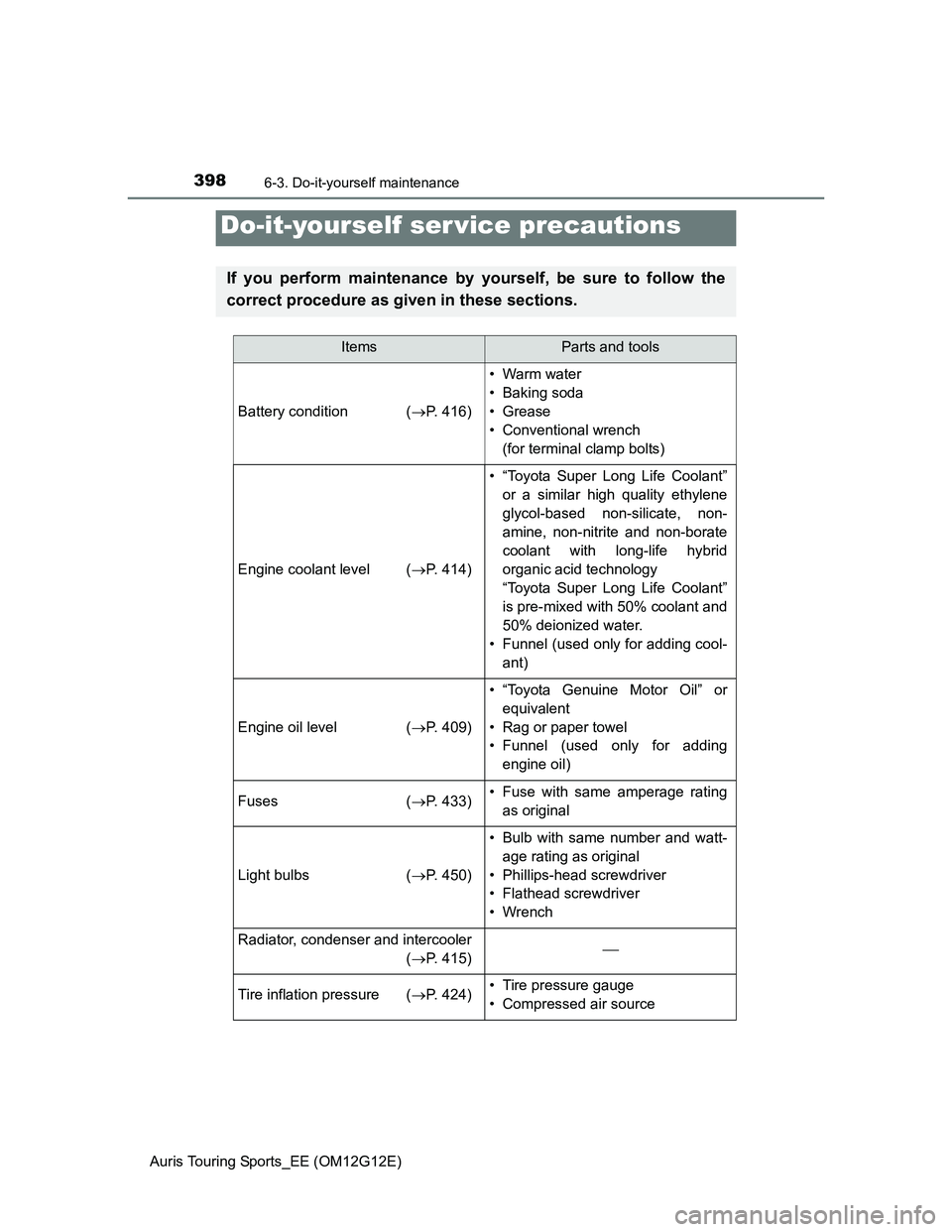
398
Auris Touring Sports_EE (OM12G12E)
6-3. Do-it-yourself maintenance
Do-it-yourself ser vice precautions
If you perform maintenance by yourself, be sure to follow the
correct procedure as given in these sections.
ItemsParts and tools
Battery condition (P. 416)
•Warm water
• Baking soda
• Grease
• Conventional wrench
(for terminal clamp bolts)
Engine coolant level (P. 414)
• “Toyota Super Long Life Coolant”
or a similar high quality ethylene
glycol-based non-silicate, non-
amine, non-nitrite and non-borate
coolant with long-life hybrid
organic acid technology
“Toyota Super Long Life Coolant”
is pre-mixed with 50% coolant and
50% deionized water.
• Funnel (used only for adding cool-
ant)
Engine oil level (P. 409)
• “Toyota Genuine Motor Oil” or
equivalent
• Rag or paper towel
• Funnel (used only for adding
engine oil)
Fuses (P. 433)• Fuse with same amperage rating
as original
Light bulbs (P. 450)
• Bulb with same number and watt-
age rating as original
• Phillips-head screwdriver
• Flathead screwdriver
•Wrench
Radiator, condenser and intercooler
(P. 415)
Tire inflation pressure (P. 424)• Tire pressure gauge
• Compressed air source
Page 423 of 616
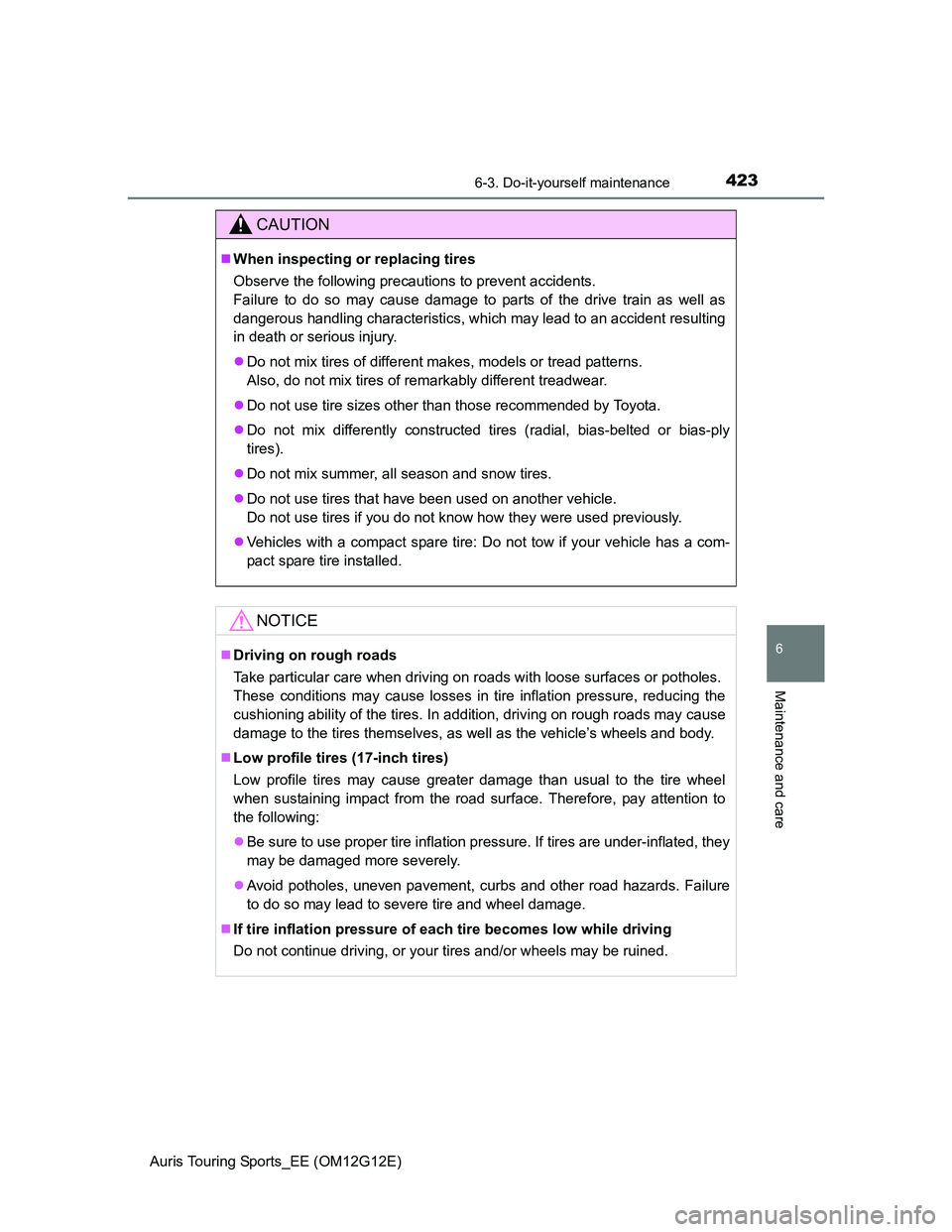
4236-3. Do-it-yourself maintenance
Auris Touring Sports_EE (OM12G12E)
6
Maintenance and care
CAUTION
When inspecting or replacing tires
Observe the following precautions to prevent accidents.
Failure to do so may cause damage to parts of the drive train as well as
dangerous handling characteristics, which may lead to an accident resulting
in death or serious injury.
Do not mix tires of different makes, models or tread patterns.
Also, do not mix tires of remarkably different treadwear.
Do not use tire sizes other than those recommended by Toyota.
Do not mix differently constructed tires (radial, bias-belted or bias-ply
tires).
Do not mix summer, all season and snow tires.
Do not use tires that have been used on another vehicle.
Do not use tires if you do not know how they were used previously.
Vehicles with a compact spare tire: Do not tow if your vehicle has a com-
pact spare tire installed.
NOTICE
Driving on rough roads
Take particular care when driving on roads with loose surfaces or potholes.
These conditions may cause losses in tire inflation pressure, reducing the
cushioning ability of the tires. In addition, driving on rough roads may cause
damage to the tires themselves, as well as the vehicle’s wheels and body.
Low profile tires (17-inch tires)
Low profile tires may cause greater damage than usual to the tire wheel
when sustaining impact from the road surface. Therefore, pay attention to
the following:
Be sure to use proper tire inflation pressure. If tires are under-inflated, they
may be damaged more severely.
Avoid potholes, uneven pavement, curbs and other road hazards. Failure
to do so may lead to severe tire and wheel damage.
If tire inflation pressure of each tire becomes low while driving
Do not continue driving, or your tires and/or wheels may be ruined.
Page 424 of 616
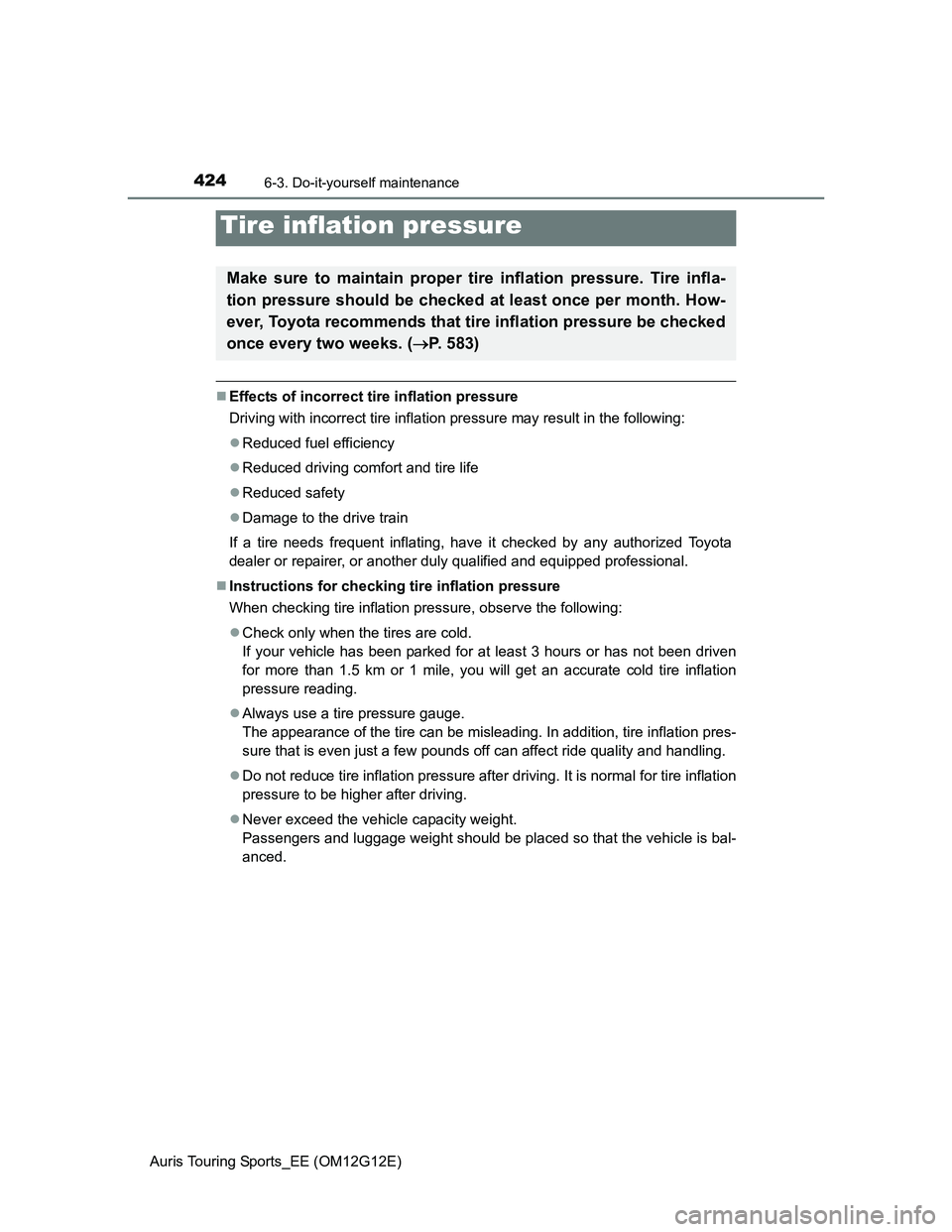
4246-3. Do-it-yourself maintenance
Auris Touring Sports_EE (OM12G12E)
Effects of incorrect tire inflation pressure
Driving with incorrect tire inflation pressure may result in the following:
Reduced fuel efficiency
Reduced driving comfort and tire life
Reduced safety
Damage to the drive train
If a tire needs frequent inflating, have it checked by any authorized Toyota
dealer or repairer, or another duly qualified and equipped professional.
Instructions for checking tire inflation pressure
When checking tire inflation pressure, observe the following:
Check only when the tires are cold.
If your vehicle has been parked for at least 3 hours or has not been driven
for more than 1.5 km or 1 mile, you will get an accurate cold tire inflation
pressure reading.
Always use a tire pressure gauge.
The appearance of the tire can be misleading. In addition, tire inflation pres-
sure that is even just a few pounds off can affect ride quality and handling.
Do not reduce tire inflation pressure after driving. It is normal for tire inflation
pressure to be higher after driving.
Never exceed the vehicle capacity weight.
Passengers and luggage weight should be placed so that the vehicle is bal-
anced.
Tire inflation pressure
Make sure to maintain proper tire inflation pressure. Tire infla-
tion pressure should be checked at least once per month. How-
ever, Toyota recommends that tire inflation pressure be checked
once every two weeks. (P. 583)
Page 425 of 616
4256-3. Do-it-yourself maintenance
Auris Touring Sports_EE (OM12G12E)
6
Maintenance and care
CAUTION
Proper inflation is critical to save tire performance
Keep your tires properly inflated. Otherwise, the following conditions may
occur and result in an accident causing death or serious injury:
Excessive wear
Uneven wear
Poor handling
Possibility of blowouts resulting from overheated tires
Poor sealing of the tire bead
Wheel deformation and/or tire separation
A greater possibility of tire damage from road hazards
NOTICE
When inspecting and adjusting tire inflation pressure
Be sure to put the tire valve caps back on.
Without the valve caps, dirt or moisture could get into the valve and cause
air leakage, which could result in an accident. If the caps are lost, replace
them as soon as possible.
Page 467 of 616
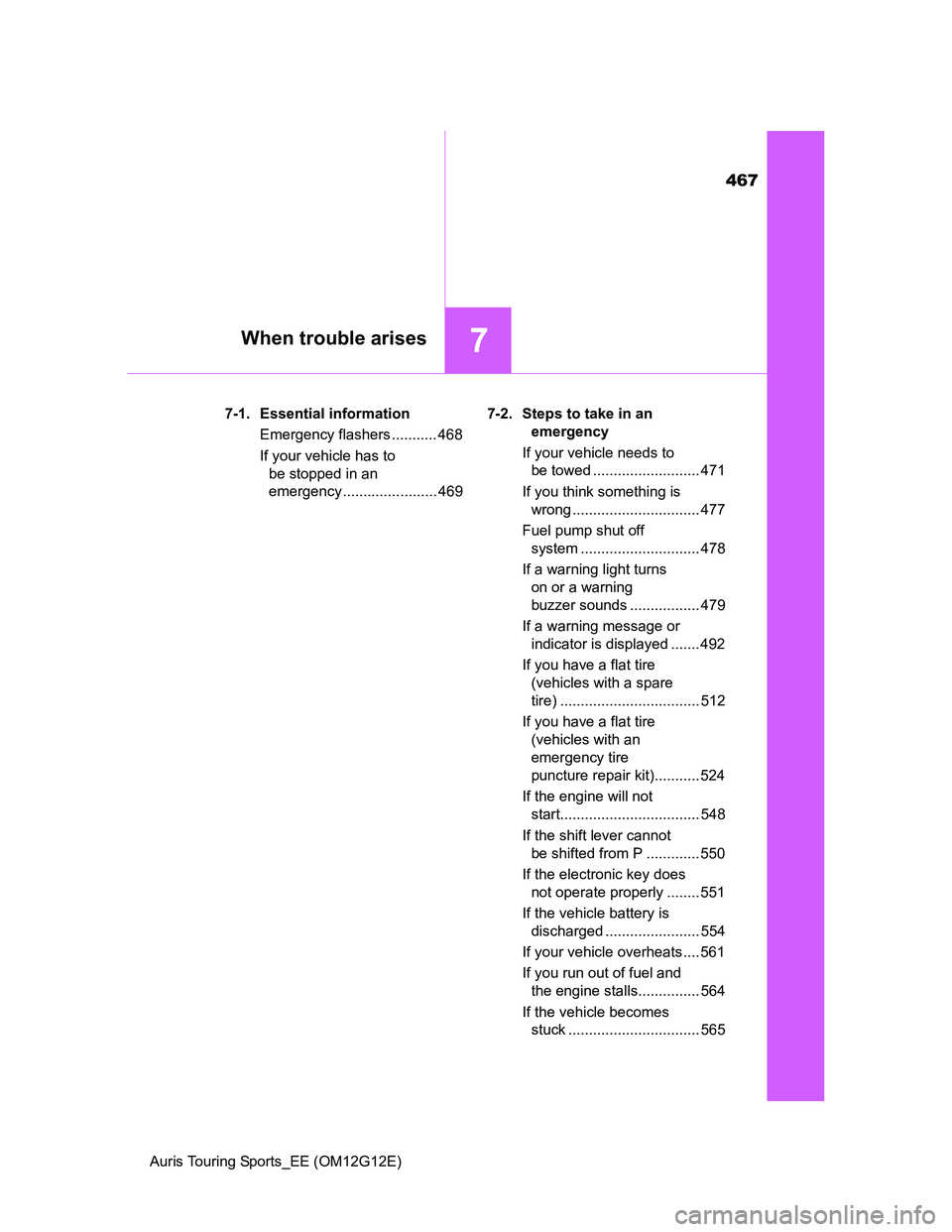
467
7When trouble arises
Auris Touring Sports_EE (OM12G12E)7-1. Essential information
Emergency flashers ........... 468
If your vehicle has to
be stopped in an
emergency ....................... 4697-2. Steps to take in an
emergency
If your vehicle needs to
be towed .......................... 471
If you think something is
wrong ............................... 477
Fuel pump shut off
system ............................. 478
If a warning light turns
on or a warning
buzzer sounds ................. 479
If a warning message or
indicator is displayed ....... 492
If you have a flat tire
(vehicles with a spare
tire) .................................. 512
If you have a flat tire
(vehicles with an
emergency tire
puncture repair kit)........... 524
If the engine will not
start.................................. 548
If the shift lever cannot
be shifted from P ............. 550
If the electronic key does
not operate properly ........ 551
If the vehicle battery is
discharged ....................... 554
If your vehicle overheats .... 561
If you run out of fuel and
the engine stalls............... 564
If the vehicle becomes
stuck ................................ 565
Page 477 of 616

4777-2. Steps to take in an emergency
Auris Touring Sports_EE (OM12G12E)
7
When trouble arises
Fluid leaks under the vehicle.
(Water dripping from the air conditioning after use is normal.)
Flat-looking tires or uneven tire wear
Vehicles without a multi-information display: High engine coolant
temperature warning light comes on.
Vehicles with a multi-information display: High engine coolant tem-
perature gauge needle continually points higher than normal.
Changes in exhaust sound
Excessive tire squeal when cornering
Strange noises related to the suspension system
Pinging or other noises related to the engine
Engine missing, stumbling or running roughly
Appreciable loss of power
Vehicle pulls heavily to one side when braking
Vehicle pulls heavily to one side when driving on a level road
Loss of brake effectiveness, spongy feeling, pedal almost touches
the floor
If you think something is wrong
If you notice any of the following symptoms, your vehicle proba-
bly needs adjustment or repair. Contact any authorized Toyota
dealer or repairer, or another duly qualified and equipped pro-
fessional as soon as possible.
Visible symptoms
Audible symptoms
Operational symptoms
Page 512 of 616
5127-2. Steps to take in an emergency
Auris Touring Sports_EE (OM12G12E)
Stop the vehicle on a hard, flat surface.
Set the parking brake.
Shift the shift lever to P (Multidrive) or R (manual transmission).
Stop the engine.
Turn on the emergency flashers. (P. 468)
If you have a flat tire (vehicles with a spare
tire)
Remove the flat tire and replace it with the spare tire provided.
For details about tires: P. 422
CAUTION
If you have a flat tire
Do not continue driving with a flat tire.
Driving even a short distance with a flat tire can damage the tire and the
wheel beyond repair, which could result in an accident.
Before jacking up the vehicle
Page 514 of 616
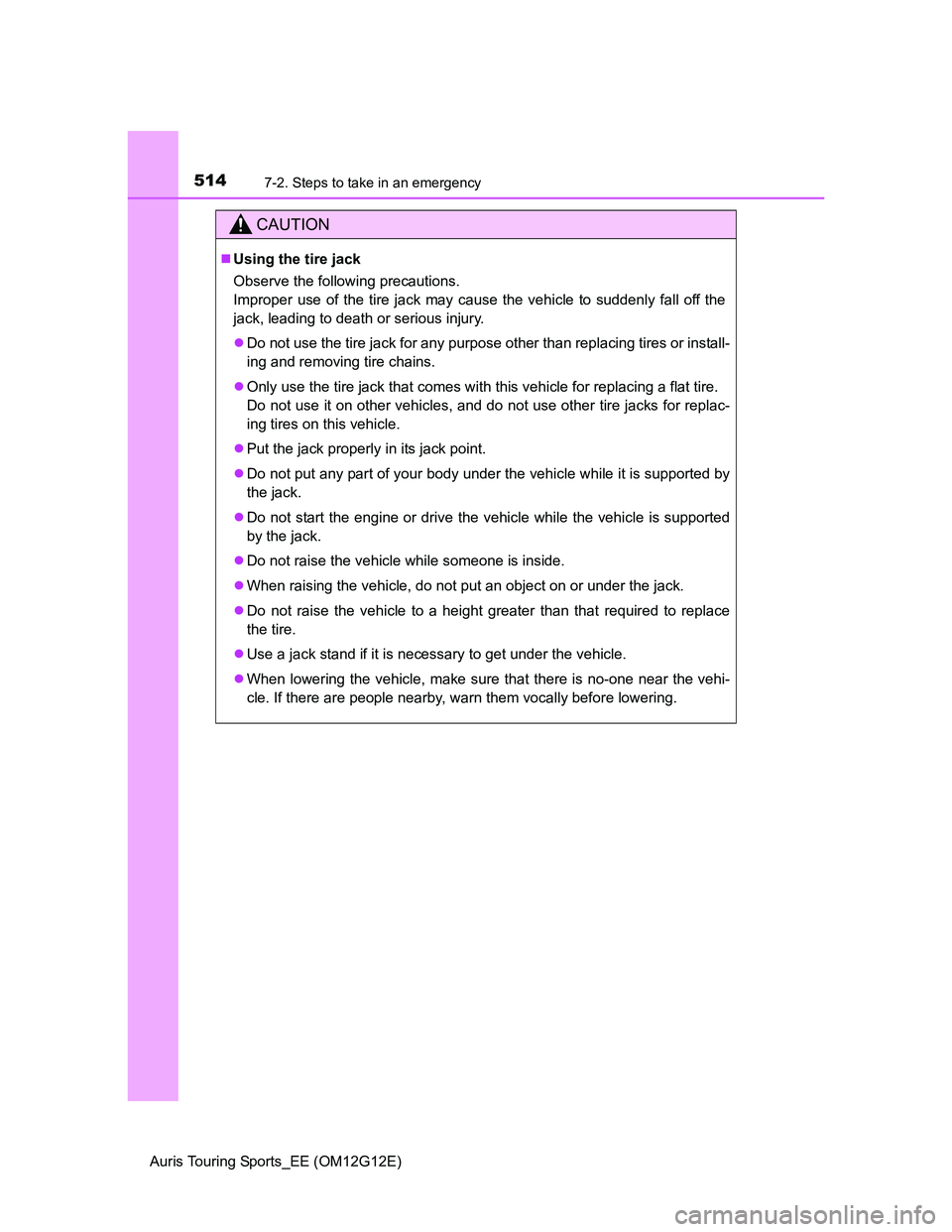
5147-2. Steps to take in an emergency
Auris Touring Sports_EE (OM12G12E)
CAUTION
Using the tire jack
Observe the following precautions.
Improper use of the tire jack may cause the vehicle to suddenly fall off the
jack, leading to death or serious injury.
Do not use the tire jack for any purpose other than replacing tires or install-
ing and removing tire chains.
Only use the tire jack that comes with this vehicle for replacing a flat tire.
Do not use it on other vehicles, and do not use other tire jacks for replac-
ing tires on this vehicle.
Put the jack properly in its jack point.
Do not put any part of your body under the vehicle while it is supported by
the jack.
Do not start the engine or drive the vehicle while the vehicle is supported
by the jack.
Do not raise the vehicle while someone is inside.
When raising the vehicle, do not put an object on or under the jack.
Do not raise the vehicle to a height greater than that required to replace
the tire.
Use a jack stand if it is necessary to get under the vehicle.
When lowering the vehicle, make sure that there is no-one near the vehi-
cle. If there are people nearby, warn them vocally before lowering.